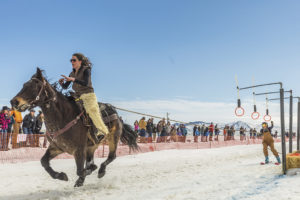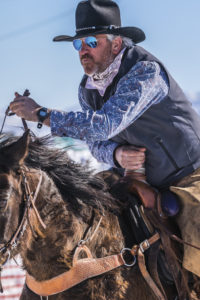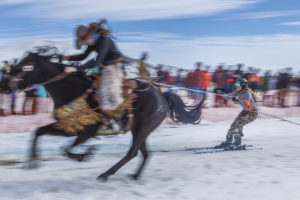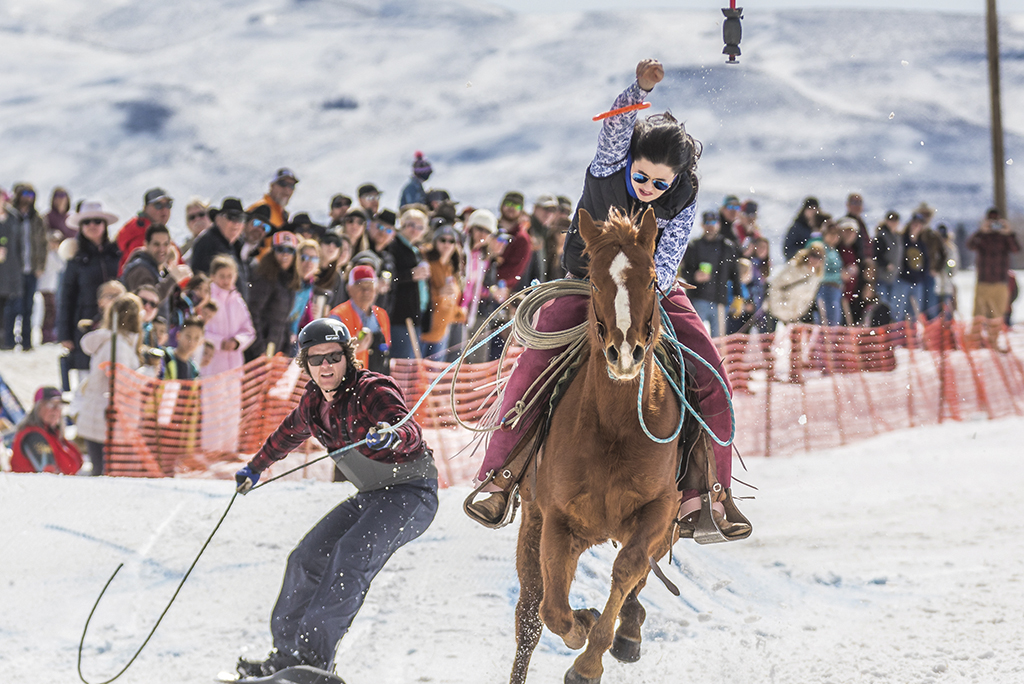It’s wintertime in Scandinavia, a long time ago. There are no cars. No buses. No roads. But you’ve got to get somewhere. So, you harness your favorite reindeer, strap on your best pair of wooden skis, and give Dasher a “giddy up!” or the Scandinavian equivalent. Then, hanging on tight to the rope tied to the mighty quadruped, you both set off across the snowy landscape under the glow of the Northern Lights.
That’s skijoring. Or, rather, that is how it started.
Like many recreational activities and sports that we enjoy, skijoring was once just a simple form of transportation. By the 20th century, it was treated as a sport in Europe and Russia, making its debut at the Nordic Games held in Stockholm in 1901. The earliest known record of Americans participating in skijoring as a pastime was in Lake Placid, New York, in 1915.
Traditional skijoring, roughly translated into “ski driving,” is a single skier pulled quickly by a reindeer, dog, snowmobile or horse through a snow-packed racecourse. American cowboys and ranchers took the sport and added Western elements. They made it rowdy. Western-equestrian skijoring typically consists of a team of three: a horse, rider and skier. The horse and rider pull a skier through a course as fast as possible.

No two courses are ever the same and may be straight or curved—and can include slalom gates, rollers, jumps and rings that skiers and/or riders must grab or catch, with penalty time added for missed elements or drops.
Today there are no two courses that are built the same. They can be straight, round, horseshoe, dogleg, or figure-eight-shaped. To add to the excitement, courses can include but are not limited to: slalom ski gates, rollers, jumps and rings that skiers and/or riders must grab or catch on a baton. Penalty time is added for missed jumps and missing or dropping rings.
When Josh Glick tells his friends about competing in skijoring, they’re often confused or shocked. “You do what now?” they ask. “You get dragged behind a horse for fun?”
Glick had been watching skijoring for years, and then one winter he and his wife Nancy decided to try it out. “We started training on our own property, with our snowmobiles and horses, and that winter we were hooked,” said Josh. They now serve on the Wood River Extreme Skijoring Association (WRESJA) board of directors.
An annual skijoring competition has been held in the Wood River Valley since the early 2000s and has garnered increasing popularity and interest from locals and beyond. Skijoring is taking its place on the circuit of sanctioned competitions for beginners and serious competitors alike.
“Races start around January 1—the Wood River competition is held President’s Day Weekend each year—and go until March with three or four races a weekend going on,” explains Michelle Bobbitt, secretary and treasurer for WRESJA.
The most popular and attended races are scattered throughout the Mountain West, from Colorado and Wyoming to Montana, Idaho and Utah. However, more races are popping up in the Midwest and East Coast yearly.
The Wood River race has from 50 to 100 teams competing each year. It’s common for people to come solo and get paired up depending on the division they’re competing in. However, more serious competitors will travel as a team. Every skijoring event has three primary divisions: Novice (beginner), Sport (amateur) and Open or Pro classes. The Wood River event also holds races for women, snowboarders, couples, and youth. Theoretically, a skier could compete multiple times per day in different divisions but never behind the same horse. And a horse may only compete in two daily races for safety concerns. In fact, it is mandatory that there not be too much snow on a course. Four to six inches is standard, so horses do not injure themselves while running.
A skijoring competition usually takes place over a weekend where teams get to compete twice. Race times for teams over the two days get combined for an overall score.

Even though the sport originated in Europe, making its debut at the 1901 Stockholm Nordic Games, skijoring has become a new American treasure.
“A race can be very close,” Glick says. “You can lose a race by missing a single ring. I have lost a race by a hundredth of a second.”
Placing on the podium or winning in an Open, Sport or Novice Division earns points and cash, which can add significantly. The points accumulate throughout the season, allowing competitors to move up divisions and compete in events like the National Finals in Red Lodge, Montana.
Most people are joining just for fun.
“In the wintertime, ranchers and cowboys are idle. That’s how it started in the West,” Glick explains. “With skijoring, you travel during the wintertime and enjoy adrenaline, competition and the comradery of this community.”
Becoming involved in the Wood River skijoring community is simple and encouraged. Give the WRESJA a call, and they can give you the information to find a horse and rider to start practicing with. The sooner the better, as there is a lot to learn, such as being towed in different snow conditions and rope management.
“Skiers are probably going 20 to 35 miles per hour,” describes Glick. “But speed isn’t everything. It’s a team sport. The rider must be aware of the conditions of the snow and the skill of the skier.”
Katelyn Berman started competing in the Wood River event three years ago with her “stocky” Halflinger named Cricket. To get Cricket in shape for skijoring, Berman will begin her training two months before a race. Some exercises include Cricket trotting in the snow and dragging a large tire around with an old climbing rope.
When asked if she thinks Cricket likes competing, Berman says, “Oh yeah, she gets so fired up at the course.”
It’s easy to see why skijoring is gaining in popularity. Fast-paced and exciting, it’s easy and fun to watch. The adrenaline, the comradery, and the obvious enjoyment from all three team members are palpable in the air. They are the quintessential American Mountain West archetypes whose values and pursuits of freedom and fun define why many of us try to live in snow-capped open spaces. They are the horse, the rider, and the skier.



